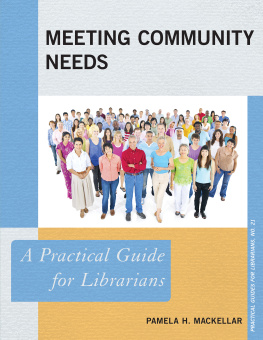The Small Library Managers Handbook
Medical Library Association Books
The Medical Library Association (MLA) features books that showcase the expertise of health sciences librarians for other librarians and professionals.
MLA Books are excellent resources for librarians in hospitals, medical research practice, and other settings. These volumes will provide health care professionals and patients with accurate information that can improve outcomes and save lives.
Each book in the series has been overseen editorially since conception by the Medical Library Association Books Panel, composed of MLA members with expertise spanning the breadth of health sciences librarianship.
Medical Library Association Books Panel
Barbara Gushrowski, chair
Lauren M. Young, AHIP, chair designate
Dorothy C. May
Karen McElfresh
Kristen L. Young, AHIP
Megan Curran Rosenbloom
Michel C. Atlas
Tracy Shields
Heidi Heilemann, AHIP, board liaison
About the Medical Library Association
Founded in 1898, MLA is a 501(c)(3) nonprofit, educational organization of 4,000 individual and institutional members in the health sciences information field that provides lifelong educational opportunities, supports a knowledge base of health information research, and works with a global network of partners to promote the importance of quality information for improved health to the health care community and the public.
Books in Series
The Medical Library Association Guide to Providing Consumer and Patient Health Information edited by Michele Spatz
Health Sciences Librarianship edited by M. Sandra Wood
Curriculum-Based Library Instruction: From Cultivating Faculty Relationships to Assessmen t edited by Amy Blevins and Megan Inman
The Small Library Managers Handbook
Alice Graves
ROWMAN & LITTLEFIELD
Lanham Boulder New York London
Published by Rowman & Littlefield
A wholly owned subsidiary of The Rowman & Littlefield Publishing Group, Inc.
4501 Forbes Boulevard, Suite 200, Lanham, Maryland 20706
www.rowman.com
16 Carlisle Street, London W1D 3 BT, United Kingdom
Copyright 2014 by Medical Library Association
All rights reserved. No part of this book may be reproduced in any form or by any electronic or mechanical means, including information storage and retrieval systems, without written permission from the publisher, except by a reviewer who may quote passages in a review.
British Library Cataloguing in Publication Information Available
Library of Congress Cataloging-in-Publication Data
The small library managers handbook / [edited by] Alice Graves.
pages cm. (Medical Library Association books)
Includes bibliographical references and index.
ISBN 978-1-4422-3987-6 (cloth : alk. paper) ISBN 978-1-4422-3013-2 (pbk. : alk. paper) ISBN 978-1-4422-3014-9 (electronic) 1. Small librariesAdministration Handbooks, manuals, etc. I. Graves, Alice, 1951 editor.
Z675.S57S63 2014
025.1dc23
2014026984
 The paper used in this publication meets the minimum requirements of American National Standard for Information SciencesPermanence of Paper for Printed Library Materials, ANSI/NISO Z39.48-1992.
The paper used in this publication meets the minimum requirements of American National Standard for Information SciencesPermanence of Paper for Printed Library Materials, ANSI/NISO Z39.48-1992.
Printed in the United States of America
The mission of the librarian is to improve society through facilitating knowledge creation in their communities.R. David Lankes
For Bill and Stephen
Contents
Acknowledgments
I wish to thank everyone who helped grow an abstract idea into the book you now hold in your hands.
First and foremost, this book would simply not be possible without the support of the Medical Library Association. I am profoundly grateful to the MLA Books Panel for allowing me the opportunity to bring this book to fruition.
A collective thank you and tip of the hat (or hats) to all of the librarians who contributed to this book. They have enriched our profession by generously sharing their successes, learning experiences, and best practices with the rest of us. May their tribe increase.
Thank you to Charles Harmon, my Sherpa at Rowman & Littlefield who was always a phone call or an e-mail away to answer my questions and guide me through this process. His encouragement and generosity of spirit served as my beacon.
Thank you to R. David Lankes, a true visionary who stands at the precipice of our evolving profession and whose enthusiasm and brilliance inspires librarians and library students everywhere.
Thank you to the great Judith Siess, whose books, articles, and blog created an awareness of solo librarians working behind the scenes in small and barely visible libraries.
I wish to thank my professors and mentors in the School of Information at the University of South Florida, who taught me well and encouraged me to work harder and happier than I ever remember working. They made me realize that this is what I was born to do.
And last but not least, I thank my husband and son for their endless love and support. I could not have completed this project without them.
Introduction
Alice Graves
The Small Library Managers Handbook is a one-stop, how-to-do-it guide to running a small library. The twenty-eight chapters that follow present the collective knowledge of librarians working in small academic, public, and special libraries. They work in hospitals, prisons, museums, colleges, courthouses, and corporations. Their libraries consist of resources ranging the entire Library of Congress and Dewey decimal classification schedules.
Small libraries, and the professionals who staff them, are frequently hidden from public view in city skyscrapers, industrial parks, museum basements, and courthouse nooks. Often their public access is limited. Small libraries and the librarians who run them may be hidden, but it is those very professionals who are responsible for keeping their libraries alive, relevant, and critical to the larger organization. The contributors to this book have emerged from the shadows to share their expertise, experiences, and best practices.
Even though librarians in small libraries are often one-man or one-woman operations, they are part of a greater organization comprised of many professionals and practitioners. Often they report to nonlibrarians who may not understand the skills and knowledge that constitute librarianship, and they must justify both the librarys worth and the librarians indispensability to that organization.
The librarian in a small library wears many hats. One might observe that the smaller the library, the more varied the role of the librarian. In addition to collection development, cataloging, and research assistance, these librarians court potential donors, master technology, write annual reports, engage in community outreach, apply for grants, and justify their very existence. They supervise volunteers, library students, and other professional librarians. In addition to the skills they learned in library school, they must develop and sharpen their administrative and organizational skills. Efficient time management is essential. A librarian may wear the hat of a new acquisitions cataloger in the morning and don a new hat later in the day to prepare the budget, research granting agencies, or meet with the organizations board of directors.
Because they usually have limited (or no) interaction with other people working in a library, solo librarians must make a concerted effort to stay connected to their profession. This can be done in person and virtually. Technology makes it simple for even the most isolated rural librarian to connect with fellow professionals daily. The plethora of professional organizations for specialized librarians makes it possible for medical librarians, prison librarians, and museum librarians to collaborate and communicate regularly.
Next page







 The paper used in this publication meets the minimum requirements of American National Standard for Information SciencesPermanence of Paper for Printed Library Materials, ANSI/NISO Z39.48-1992.
The paper used in this publication meets the minimum requirements of American National Standard for Information SciencesPermanence of Paper for Printed Library Materials, ANSI/NISO Z39.48-1992.